Preprint
Article
Architectural Experimentations. New Meanings for Ancient Ruins
Altmetrics
Downloads
75
Views
35
Comments
0
A peer-reviewed article of this preprint also exists.
This version is not peer-reviewed
Submitted:
31 May 2024
Posted:
10 June 2024
You are already at the latest version
Alerts
Abstract
From the critical premises that underpin the debate between archeology and architecture, evi-dence emerges, namely that the musealization of building or urban remains of the past is even more harmful, for the purposes of its real understanding, than that of any other artefact. In a country, Italy, that has archeological presences more than any other, architecture must contribute to overcoming the consolidated aporia that the Contemporary, understood not only as a period but also and above all as its “forms and functions”, it’s structurally in opposition to the conser-vation of the archeological heritage. What is presented is an attempted exercise for “inhabiting archaeology”, that is, trying to re-grant inclusive usability to a historical fragment, which has lost the elements necessary for its habitability. The set of questions, doubts and steps have been high-lighted more than the final “figure” of the project: an essential form directly connected with the primordial principles of its constitution, for a project that protects and encourages to visit the complex, trying to offer new perspectives, new narratives and new connections that translate into the possibility of being – for those who visit this place – the protagonists of a unique experience made of history, memory and continuous discoveries.
Keywords:
Subject: Arts and Humanities - Architecture
1. An Open Question Between Ancient and Modern
Archaeological presences have always been a widely debated topic in the architectural and urban spheres, especially in a strongly anthropized territory such as Italy, which has, more than in other contexts, a strong and widespread presence of traces of the past. In Italy, the nation with the highest number of UNESCO sites in the world [1], we have always had to come to terms with the “presence of the past”, which was also the emblematic title of the first Venice Architecture Biennale in 1980 [2]. In recent years, the relationship between architecture and archaeology has been the focus of specific research and projects: an accumulation of materials and experiences that have legitimized architecture’s contribution to the configuration of archaeological sites [3]. If archaeology, through excavation, initiates a discourse on the ancient, it is up to architecture, through the tool of the project, to continue this narrative by offering new meanings for ancient ruins: what is striking is their ability to provide a sense of time without summarizing history and without concluding it in the illusion of knowledge, turning into a work of art without a past [4].
Looking at the contemporary landscape, consisting of the multiple forms through which the project is expressed and relates to archaeological sites, the desire to work in situ is relevant, allowing the context of the ruins to be an integral part of the visitor’s experience, as well as a starting point for the project. Leaving a work in situ can be seen as a response, a strong stance against the “nefarious epidemic” [5] (p. 395) of disposable exhibitions, which rather than aiming at a real cultural enrichment, offer to all intents and purposes a service to customers, in a fetishistic loop of a consumerist nature. It is preferable to prevent the work under scrutiny from being transported, or disassembled and reassembled, despite itself “to a museum, the place where each power becomes immobile, detonated, observable [...] like a taxidermied animal” [6] (p. 127). We can affirm that only together with the context an architectural work – or what remains of it – is truly legible: architecture has always refrained – for obvious material and functional reasons – from its possible non-locality and imperturbability with respect to a given context. The same frame, so defined and clear-cut for pictorial works, blurs completely and becomes untraceable around a constructed building: where does nature’s landscape end, where does man’s art begin? The answer is that this fusion of the elements is the true masterpiece, exactly what we call the context [7]. Otherwise, a sort of disengagement, a paradoxical short-circuit, could only arise, which acts as soon as the work is detached from its necessary surroundings and that estrangement from unexpected detachment arises, well represented by filmic scenes such as that of the acephalous Etruscan goddess “hanging” in Rohrwacher’s recent film La Chimera, which is an explicit quotation of the “flying” Christ in Fellini’s La dolce vita. The architectural fragment assumes the role of trait d’union, between the state of an archaeological pre-existence in its singularity of material fact and a surrounding context (lithic, vegetal and meteorological) that cannot be excluded in any way from the design thinking. “Pilar Carrera, by exploring the concept of the fragment [...], emphasizes its semantic condition proper to a space of emergence of meaning” [8] (p. 88). The fragment, a partial “restanza” [9] of a totality which has been lost, must be considered as a trigger mechanism, a real perturbing for the one who questions it, a basic matrix generating ideas. Each fragment is, potentially, in the hands and eyes of the one who carefully listens to it, an objet trouvé with a poetic reaction: the imagination is best activated in the waste, in the cracks and gaps of reality. The incompleteness of the fragment in the form of a synecdoche (a part for the whole) is a harbinger of ideas, connections, intuitive leaps: because it is by its very nature that, if overwhelmed by information, the imagination dies. “High definition [...] informational does not allow anything indefinite to exist. But imagination inhabits an indefinite space. Information and imagination are opposing forces” [10] (p. 67).
2. The Reasons of a Project
This contribution aims to recount a design research experiment that, starting from a specific case study, seeks to define a possible methodology of making architecture among the ruins, keeping the presence of history at the center, enriching it with meanings, aggregating new forms, subtracting the superfluous, to define a possible scenario: a future we can no longer look at with the eyes of a twentieth century of excess and total overwriting of the existing [11], but rather with the gentle gaze of one who wants to write alongside the past. Among the architect’s tasks is the care of heritage and its contexts, which need a narrative that the architectural project can give back to the present and future society [12]. The participation in a competition of ideas, promoted by the municipality of Curinga, in the province of Catanzaro, with the aim of raising public awareness of a heritage currently in a state of neglect, becomes an opportunity to give form to some theoretical hypotheses formulated in the university sphere. The competition was born with the aim of finding original and innovative solutions for the complex of the ancient baths, with the purpose of reopening the archaeological site by making it usable in an inclusive way. The entire design process, narrated below, seeks to build the basis for defining an operational research method aimed at “inhabiting archaeology”.
3. The Traces of a Method
Starting from these traces, the project seeks to establish a dialogue not only with the circumscribed object of the thermal ruins, but also with the equally anthropic and artificial but plant-like surroundings (Figure 1 and Figure 2), avoiding the emulation of exhibition experiences in which the ruins are treated not as texts to be interrogated with respect, but as sumptuous sets, as legitimizing frames [13]. This is an attempt to respond to the call made by Francesco Venezia: ruins are “the object of a science that proposes to reconstruct the history and art of remote times through the remains of the past, on which a series of reflections, reconstructions, conjectures are spread, interesting, highly scientific, but absolutely inadequate compared to what life is. [...] The world of ruins has entered a sort of jealously protected reserve that is absolutely separated from the place of architecture” [14] (pp. 16-17). This condition makes it difficult to redesign artefacts that find their reason for relevance solely in the patina of time between their creation and the present [15,16]. Our endemic tradition prevents highly interesting works that, while taking the risks of an unflinching revision of the architectural work, make ancient spaces habitable again. The project becomes „profanatory” [17]: profanation indicates the restoration of the use of things that, through consecration, are reserved for deities in a broad sense: for a very restricted use in the social status of its users and are thereby removed from the use of all [18]. This does not mean that a more intransigent stance cannot be taken, especially regarding highly significant architecture that deserves a conservation approach; at the same time, the regeneration of artefacts, building complexes and parts of cities that do not have special value, such as to elevate them from building status to architectural status, must be facilitated. It has been paid attention to the reversibility of the architectural gesture, to allow the metamorphosis of spaces over time, while respecting the existing. A reversible project expresses characters of temporariness, a rethinking of the logical traditions of building.
4. The Design Process
The project was created to protect the archaeological plan of the Curinga Baths, facilitating use and accessibility for all categories of visitors. Spatium ad Omnes is an open space conceived to involve the users, protagonists of an experiential pathway of an important heritage (Figure 3). The design thinking is confronted with a strategy of sustainable action that involves the reinterpretation of the ruins while maintaining their historical significance. The itinerary starts from a clearing that invites visitors to reach the site in orthogonal directions: a cardo and decumanus, which after a series of contemplative pauses, lead to an open-air theatre (Figure 4). The square roof, whose openings on the surface are defined by the upward projection of the ancient plan, defines the spaces, frames the area and bends at the entrances, making them recognizable (Figure 5). The roof is supported by thin pilotis arranged in an apparently random manner, but which evoke the ancient volumes (frigidarium, tepidarium, calidarium, natatio).
The vertical load-bearing elements are accompanied by metal meshes that „cover” the planimetric design and evoke the ancient spatiality. The threshold envelops the visitor and guides him through the various rooms: it is only an apparent and evocative limit, as one can penetrate it with the gaze and sometimes even physically (Figure 6). Beams, pillars and wire mesh go beyond the material value, becoming conceptual projections of a remote past that, thanks to the project, becomes present (Figure 7). The correlation between techniques, the redesigning of the ground and the identification of a principle for the reinterpretation of spaces are essential elements of the proposal. It becomes necessary to establish reference points on which to base ideas; foundations, built through various in-depth studies, enter the tangle of the complexity of the experimentation and present a hypothesis of structure that organizes architecture through an exercise in punctual clarity, a strategy that brings together discrete interventions capable of vast changes in meaning. Based on the principle of reversibility, the transformation of space implies planning in advance the possibility of dismantling, involving materials and assembly techniques (Figure 8). Importance is given to the simplicity of the architectural gesture, which makes the coexistence of the two coexisting historical moments clear and comprehensible, without denying the existence and material value of their difference [19]. The reasons for a project must reveal and not cover, reconnect, and not isolate, describe a discourse around preset limits. One cannot maintain an immobile, pre-constructed thought. Design in balance, with attention to measure, to relationships, to architectural organization in the various directions: while remaining aware of the precariousness of this balance, one nevertheless aims to pursue it tenaciously.
5. Conclusions
From the critical premises arguing the debate between archaeology and architecture, an evidence emerges: the museification of building or urban remains of the past is even more harmful, for the purposes of a real understanding of it, than that of any other artefact; this is why contemporary architecture can play a fundamental role in clarifying reasons that are no longer evident or in resuscitating exhausted relations [20]. In a country that has, more than any other, archaeological presences, architecture can help to break out of the established aporia that the contemporary, understood not only as time, but also and above all as form and function, is structurally in opposition to the conservation of archaeological heritage [21]. It is wrong to consider an architecture for archaeology as a pre-constituted approach, specialized on certain themes, to which to respond with a predetermined “contemporary style”, devoid of any experimental imprint. Instead, it is useful to set out the reasoning on the relationship between architecture and archaeology, starting from the specificity of two disciplines that have often intertwined and for which a ground for dialogue and continuous confrontation has been determined [22]. The project under consideration stands as an attempted exercise of “inhabiting archaeology”, that is, trying to rediscover and re-grant a usability (as inclusive as possible) to a historical fragment that by its very nature has lost the elements and spaces necessary for its habitability, understood in a broad sense. Faced with a series of archaeological elements, the design of the recomposition is a work of invention that uses an extraordinary material, which itself is memory [23]. Paraphrasing Gilles Deleuze, the design is realized in the opposition between the inactual and the actual, between our time and what is untimely [24]: to do so, we started by attempting to interrogate the ruin both in its presence (actual) and in its absence (inactual), since “the volumetric simplicity of the singular elements, the places-absences [. ..] denoting the ancient city and its surroundings suggest ways of thinking about the future city, show expressive potentialities of space” [25] (p. 9). The outcome appears as a fluctuating cover protecting the archaeological plane that gives habitability to the space, within which the pathway crosses a raised walking surface (Figure 9).
The themes we focus on tend to emphasize design experimentation through hypotheses and solutions that include the versatility of space, accessibility, sustainability, and reversibility of architectural interventions. Archaeological sites are becoming more and more permeable, open, and safe, capable of being microcosms of experimentation that can contribute to reminding us of the possibilities and extraordinary complexity of the time we are living [26]. The process of research design experimentation presented in this contribution, has criticalities connected to its having been conceived in a competition of ideas - therefore unrelated to its technical-economic feasibility, its material consistency and detailing on a small scale. Rather than the final “figure”, the one presented was intended to be the set of questions, doubts and steps that proved useful in making it appear.
The result is a choice between an infinity of trials, deletions, sketches, hesitations, and visualizations. The effect is a form that is essential in all its parts and directly connected to the primordial principles of its own constitution, a project that protects and encourages the visit of the complex, offering new glances, new narratives and new connections that result in the possibility for those who visit these places, to be the protagonist of a unique experience, made of history, memory and continuous discoveries.
Funding
This research received no external funding.
Conflicts of Interest
The authors declare no conflicts of interest.
References
- Ippolito, F. Paesaggi frantumati. Atlante d’Italia in numeri, 1st ed.; Skira: Milan, Italy, 2019. [Google Scholar]
- Mosco, V.P. Architettura italiana. Dal postmoderno ad oggi, 1st ed.; Skira: Milan, Italy, 2017; p. 19. [Google Scholar]
- Miano, P. Indagine archeologica e programma architettonico. In Paesaggi di rovine. Paesaggi Rovinati, 1st ed.; Capuano, A., Ed.; Quodlibet: Macerata, Italy, 2014; pp. 252–261. [Google Scholar]
- Augé, M. Rovine e macerie. Il senso del tempo, 1st ed.; Bollati Boringhieri: Turin, Italy, 2004. [Google Scholar]
- Brandi, C. Le mostre, ahimè (1968). In Il patrimonio insidiato. Scritti sulla tutela del paesaggio e dell’arte, 1st ed.; Capati, M., Ed.; Editori Riuniti: Rome, Italy, 2001; p. 395. [Google Scholar]
- Caffo, L. Quattro capanne. O della semplicità, 1st ed.; Nottetempo: Milan, Italy, 2020; p. 127. [Google Scholar]
- Montanari, T.; Trione, V. Contro le mostre, 1st ed.; Einaudi: Turin, Italy, 2017. [Google Scholar]
- De Caro, V. Permanence and Continuity of the Project. Relations Between Persistent Structures and Contemporary Interventions. In Urban Corporis – To the Bones, 1st ed.; Milocco Borlini, M., Califano, A., Riciputo, A., Eds.; Eds.; Anteferma: Conegliano, Italy, 2014; pp. 86–93. [Google Scholar]
- Teti, V. La restanza, 1st ed.; Einaudi: Turin, Italy, 2022. [Google Scholar]
- Han, B. Eros in agonia, 1st ed.; Nottetempo: Milan, Italy, 2019. [Google Scholar]
- La Varra, G. Architettura, ordine e disordine. Multiverso 2017, 15, 39–41. [Google Scholar]
- Richiusa, E. Patrimonio. In Le parole e le forme – Book of Papers. Decimo Forum ProArch, 1st ed.; Arrighi, L., Canepa, E., Lepratti, C., Moretti, B., Servente, D., Eds.; ProArch – Società Scientifica del Progetto di Architettura: Rome, Italy, 2023; pp. 930–935. [Google Scholar]
- Montanari, T.; Trione, V. Contro le mostre, 1st ed.; Einaudi: Turin, Italy, 2017. [Google Scholar]
- Venezia, F. Che cosa è l’architettura. Lezioni, conferenze, un intervento, 2nd ed.; Electa: Milan, Italy, 2022; pp. 16–17. [Google Scholar]
- Arboleda, P. Reimagining Unfinished Architectures. Ruin Perspectives Between Art and Heritage. Cultural Geographies 2019, 26/2, 227–244. [Google Scholar] [CrossRef]
- Bagnoli, L. Urban Carcasses. The Reinterpretation of Unfinished Spatiality. In Urban Corporis – To the Bones, 1st ed.; Milocco Borlini, M., Califano, A., Riciputo, A., Eds.; Anteferma: Conegliano, Italy, 2023; pp. 78–85. [Google Scholar]
- Agamben, G. Profanazioni, 1st ed.; Nottetempo: Milan, Italy, 2005. [Google Scholar]
- Han, B. Eros in agonia, 1st ed.; Nottetempo: Milan, Italy, 2019. [Google Scholar]
- Gregotti, V. Dentro l’architettura, 1st ed.; Bollati Boringhieri: Turin, Italy, 1991. [Google Scholar]
- Ferlenga, A. Il dialogo interrotto delle rovine di ogni tempo. IUAV Giornale dell’Università 2010, 81, 2. [Google Scholar]
- Aymonino, A. Recinti versus esperienza. IUAV Giornale dell’Università 2010, 81, 4. [Google Scholar]
- Miano, P. Indagine archeologica e programma architettonico. In Paesaggi di rovine. Paesaggi Rovinati, 1st ed.; Capuano, A., Ed.; Quodlibet: Macerata, Italy, 2014. [Google Scholar]
- Rossi, A. Architettura, architettura analitica, città analoga. In Quaderni azzurri: 1968-1992, 1st ed.; Dal Co, F., Ed.; Electa: Milan, Italy, 1999. [Google Scholar]
- Deleuze, G. Nietzsche e la filosofia, 1st ed.; Feltrinelli: Milan, Italy, 1992; p. 160. [Google Scholar]
- Dal Fabbro, A. Astrazione e memoria. Figure e forme del comporre, 1st ed.; CLEAN: Naples, Italy, 2009; p. 9. [Google Scholar]
- Aymonino, A. Recinti versus esperienza. IUAV Giornale dell’Università 2010, 81. [Google Scholar]
Figure 1.
The site and its context.
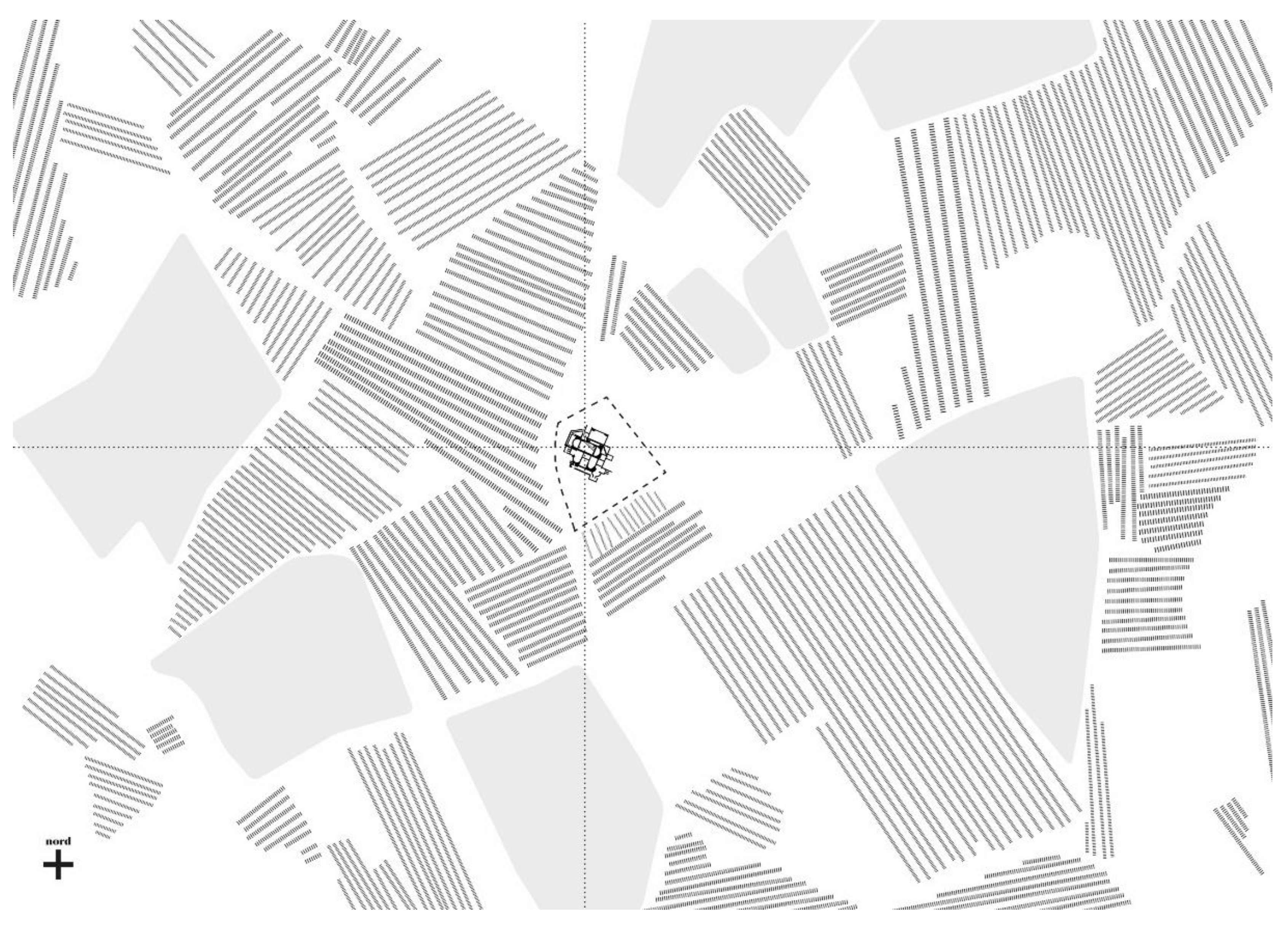
Figure 2.
Project morphogenesis.
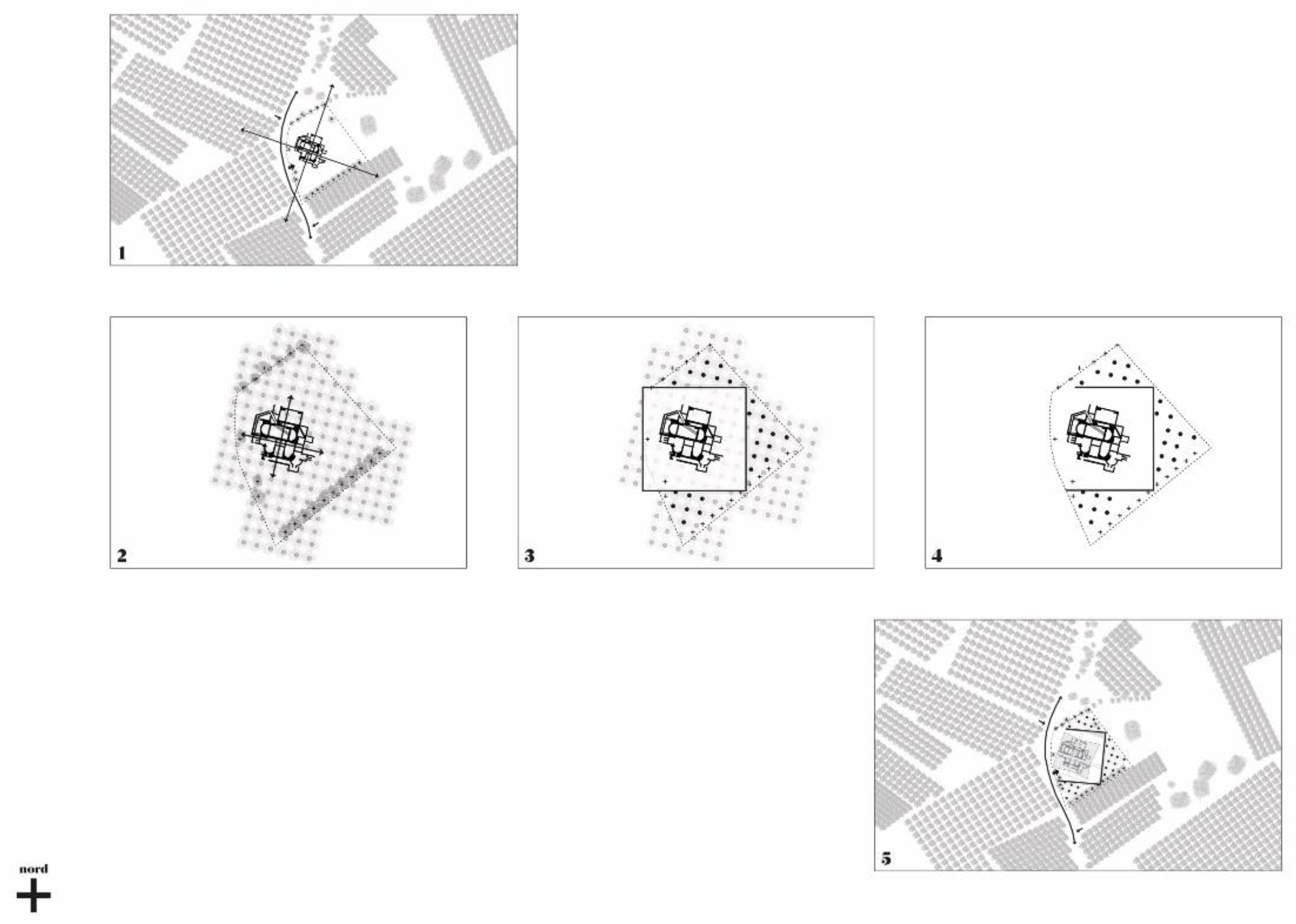
Figure 3.
New paths to explore the ancient ruins.
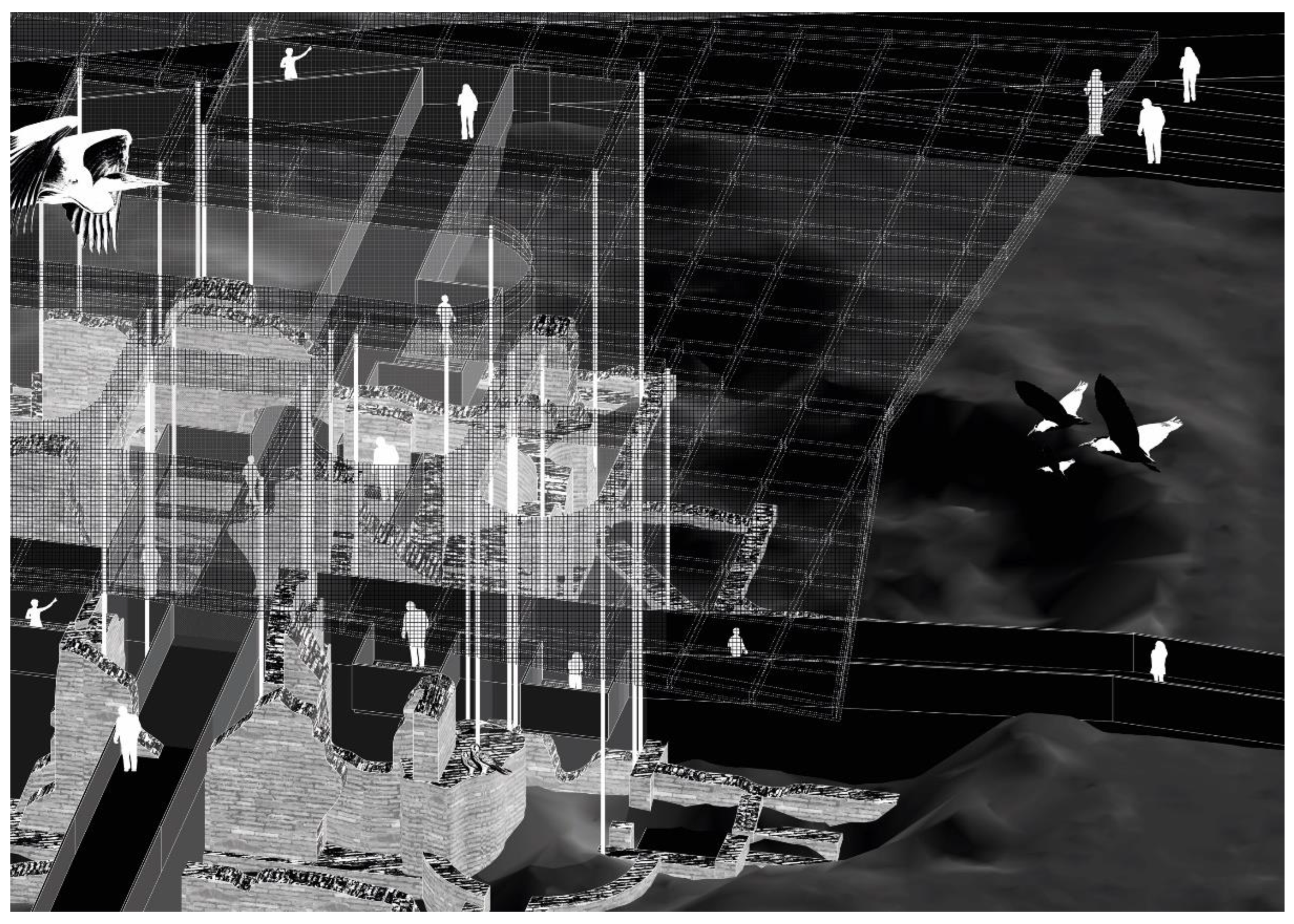
Figure 4.
The project in its context.
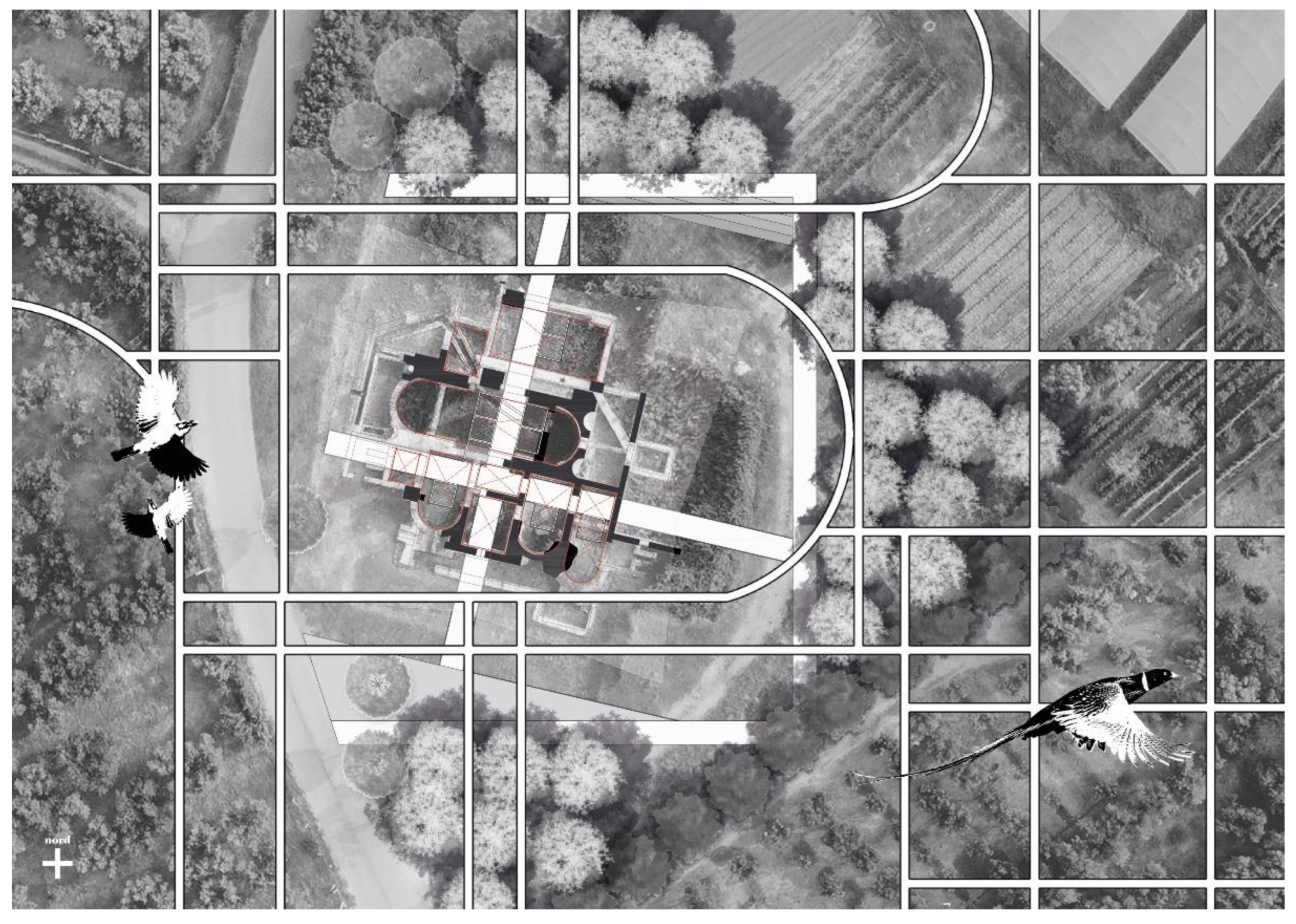
Figure 5.
Project morphogenesis of the coverage.
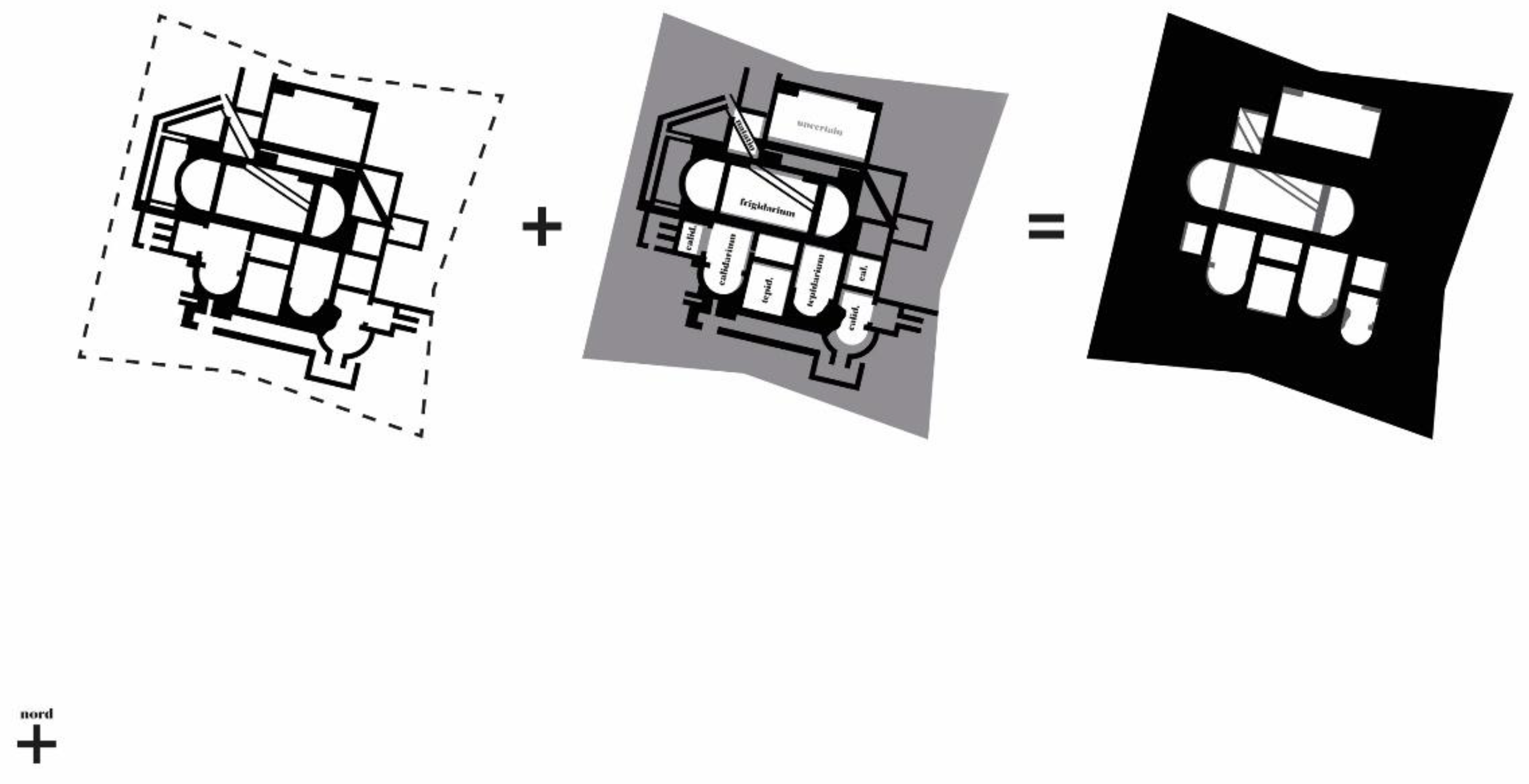
Figure 6.
A view across the project.
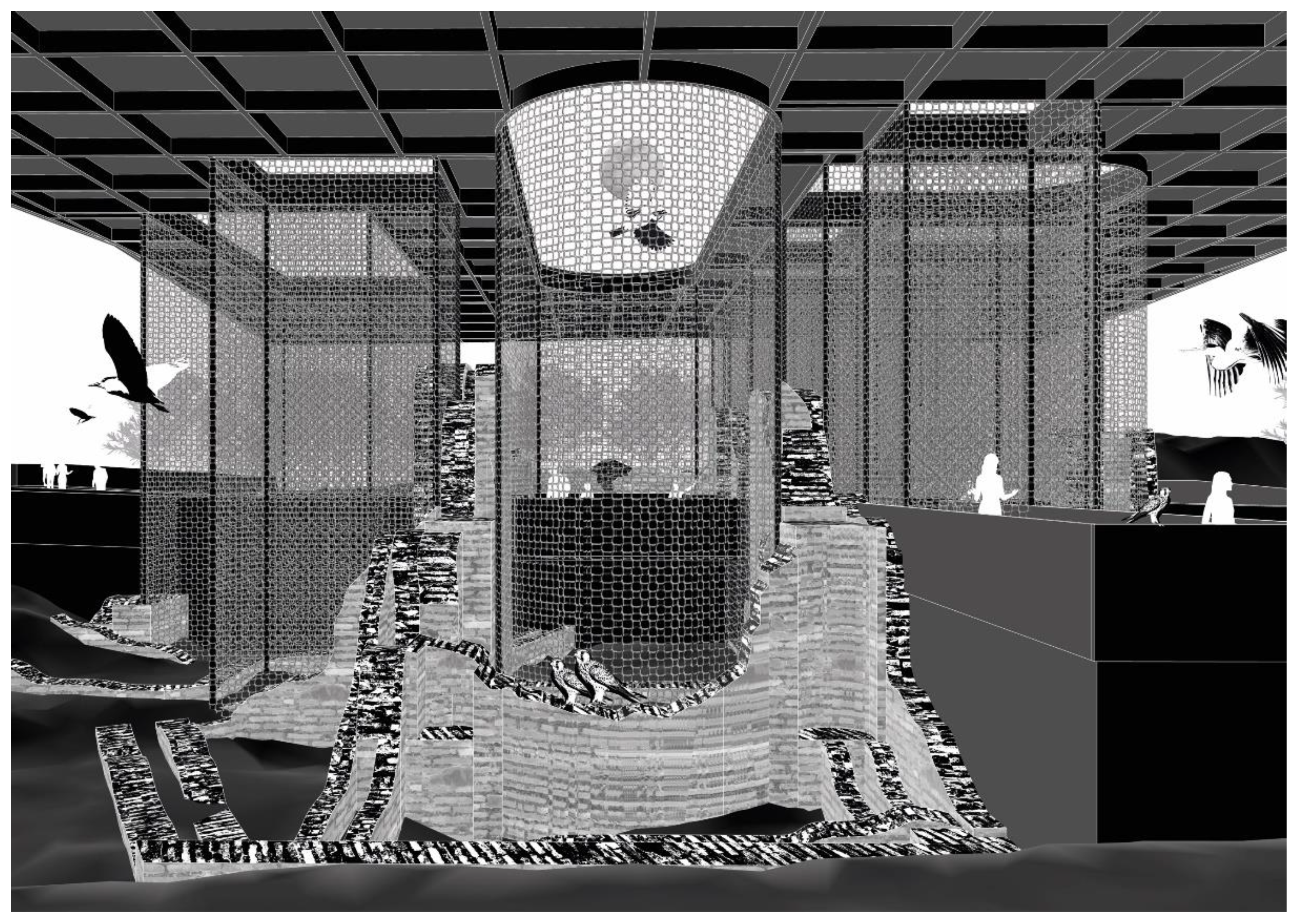
Figure 7.
Project cross section.
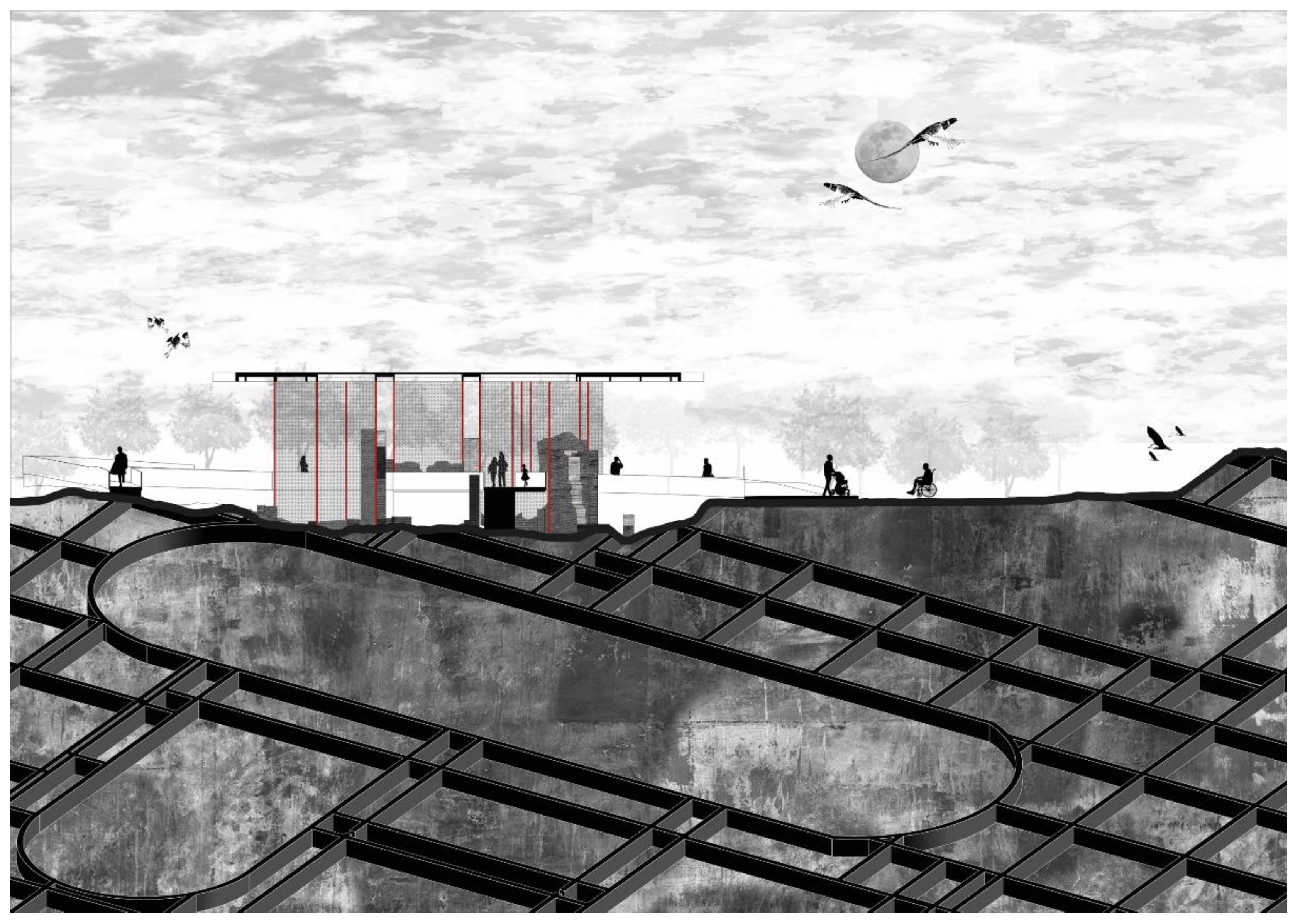
Figure 8.
The new roof and the ancient ruins (metaphorical representation of the project).
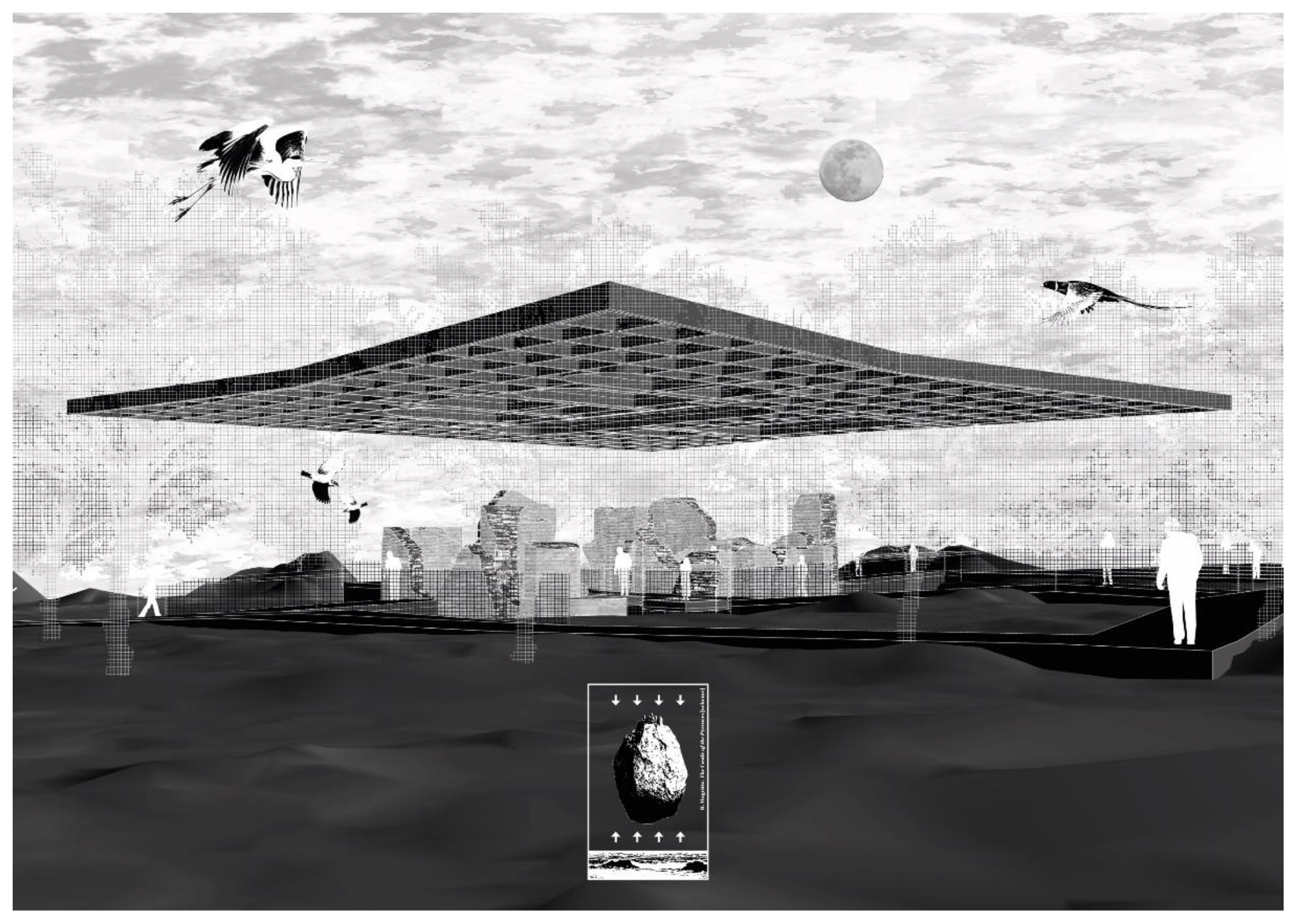
Figure 9.
The project assembly.
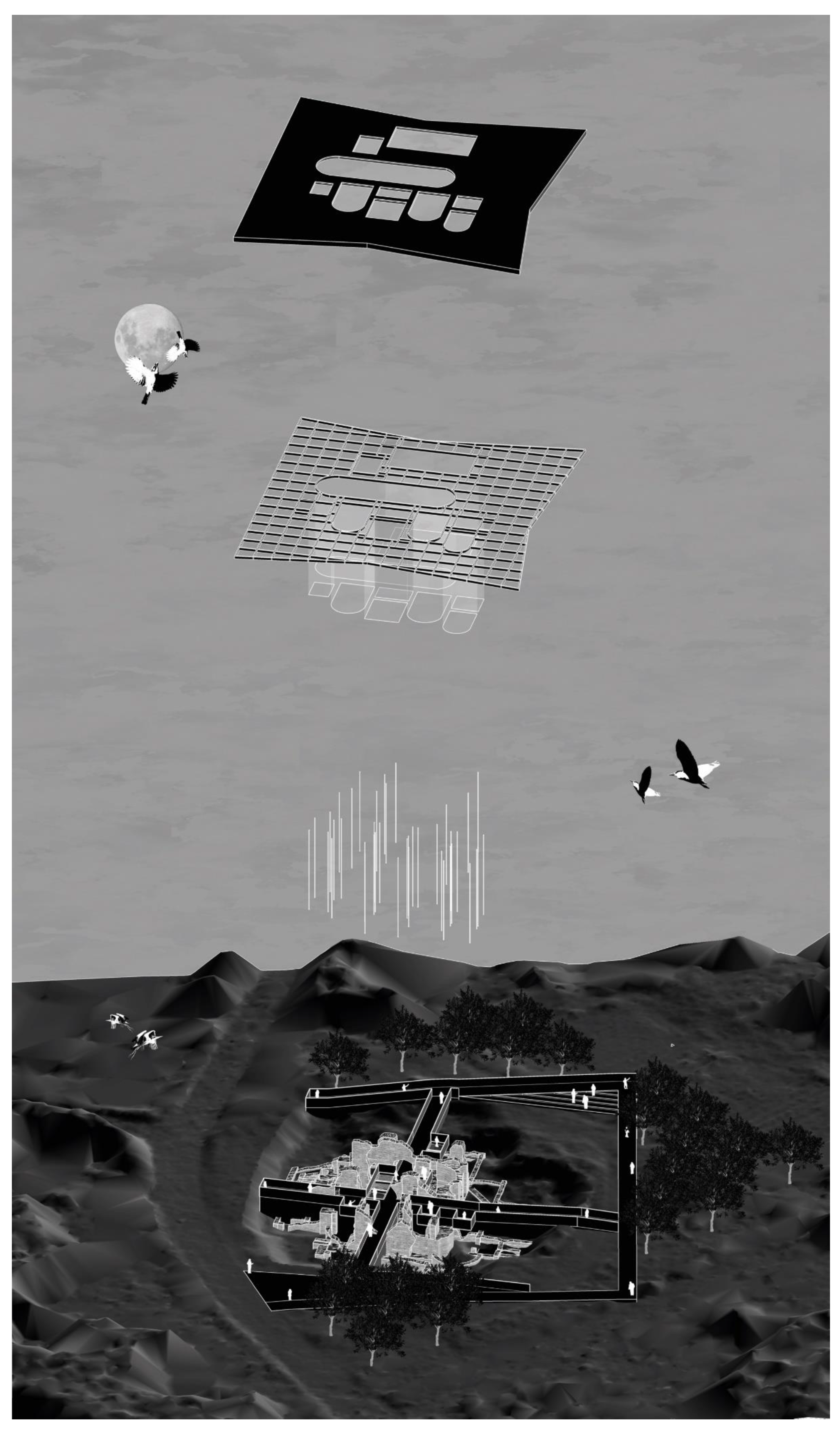
Disclaimer/Publisher’s Note: The statements, opinions and data contained in all publications are solely those of the individual author(s) and contributor(s) and not of MDPI and/or the editor(s). MDPI and/or the editor(s) disclaim responsibility for any injury to people or property resulting from any ideas, methods, instructions or products referred to in the content. |
© 2024 by the authors. Licensee MDPI, Basel, Switzerland. This article is an open access article distributed under the terms and conditions of the Creative Commons Attribution (CC BY) license (http://creativecommons.org/licenses/by/4.0/).
Copyright: This open access article is published under a Creative Commons CC BY 4.0 license, which permit the free download, distribution, and reuse, provided that the author and preprint are cited in any reuse.
MDPI Initiatives
Important Links
© 2024 MDPI (Basel, Switzerland) unless otherwise stated





